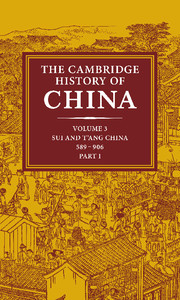Book contents
- Frontmatter
- 1 Introduction
- 2 The Sui dynasty (581–617)
- 3 The founding of the T'ang dynasty: Kao-tsu (reign 618–26)
- 4 T'ai-tsung (reign 626–49) the consolidator
- 5 Kao-tsung (reign 649–83) and the empress Wu: the inheritor and the usurper
- 6 The reigns of the empress Wu, Chung-tsung and Jui-tsung (684–712)
- 7 Hsüan-tsung (reign 712–56)
- 8 Court and province in mid- and late T'ang
- 9 Court politics in late T'ang times
- 10 The end of the T'ang
- Glossary Index
- References
10 - The end of the T'ang
Published online by Cambridge University Press: 28 March 2008
- Frontmatter
- 1 Introduction
- 2 The Sui dynasty (581–617)
- 3 The founding of the T'ang dynasty: Kao-tsu (reign 618–26)
- 4 T'ai-tsung (reign 626–49) the consolidator
- 5 Kao-tsung (reign 649–83) and the empress Wu: the inheritor and the usurper
- 6 The reigns of the empress Wu, Chung-tsung and Jui-tsung (684–712)
- 7 Hsüan-tsung (reign 712–56)
- 8 Court and province in mid- and late T'ang
- 9 Court politics in late T'ang times
- 10 The end of the T'ang
- Glossary Index
- References
Summary
FISCAL PROBLEMS, RURAL UNREST AND POPULAR REBELLION
It was only after 884, at the very end of the dynasty, that the T'ang dynastic house finally abandoned its attempt to control all of China proper, and until then it never really lost its sovereignty over any part, however little actual authority it had in some areas. Even in the most obdurately independent provinces, T'ang titles were inevitably adopted, and formal court appointment to office was usually sought. Thus the T'ang continued to maintain a presence even in places it could not govern. But its frequent and costly efforts to reassert authority in ‘rebellious’ areas, the inescapable need to defend the empire from foreign invasions, and the maintenance of a large bureaucracy even after the central government's effective administrative power had been severely diminished, all put serious pressures on the resources actually at the dynasty's command. Those pressures led to a series of cumulative developments, each more serious and complex than the last: from 780 to 820 an increasing tax burden was loaded upon the peasantry, to support campaigns to restore dynastic unity; from 820 to 860 a growing pattern of disorder and local banditry emerged; from 860 to 875 broadly supported garrison insurrections broke out, coupled with a serious attempt to form an independent regional state in the lower Yangtze valley; from 875 to 884 a popular rebellion of immense proportions arose. The rebels captured the T'ang capital and held it for more than two years.
- Type
- Chapter
- Information
- The Cambridge History of China , pp. 682 - 789Publisher: Cambridge University PressPrint publication year: 1979
References
- 4
- Cited by



